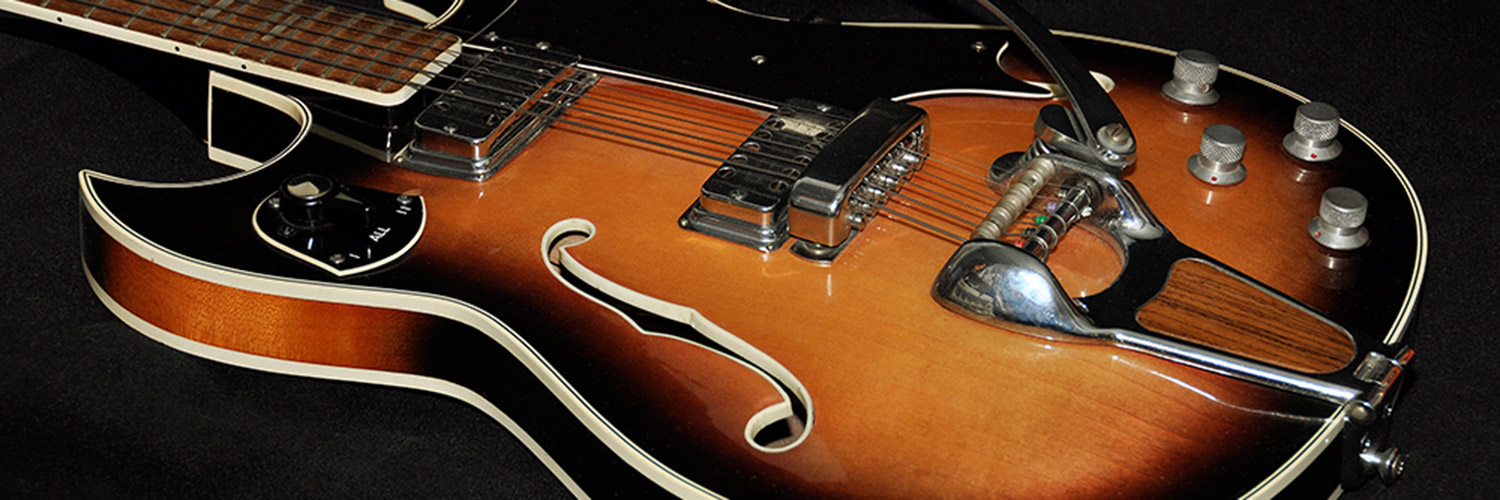Crucianelli Florentine
by Jack Marchal
The idea of making a compact florentine semi-acoustic (some kind of inflated SG) was certainly inspirated by Eko. However, instead of the kitschy toylike appearance of the Eko Florentine, Crucianelli choosed to give its guitar an image of seriousness, just enriched by a touch of originality with the Batwing pickguard.
The mother-of-pearl inlays and the tasteful lacquer finish exsude high quality craftmanship. All in all, this a rock’n roll instrument any jazz musician could be seen with without being ashamed.
L’idea di creare una semi-acustica compatta a spalle fiorentine (un “diavoletto” gonfiato) è senz’altro stata ispirata da Eko. Però, in contrasto con l’aspetto di giocattoli kitsch delle Eko Florentine, Crucianelli ha scelto di dare a queste chitarre un’immagine di serietà, solo arricchita d’un tocco di originalità nel profilo alla Batman del battipenna.
Gli intarsi di madreperla e la verniciatura molto curata riflettevano un alto livello qualitativo. In breve, ecco uno strumento rock con cui un musicista di jazz poteva farsi vedere senza vergognarsi.
The first generation was fitted with the pickups introduced in 1964 on the older solidbodies. The trem device offered as an option is actuated by a nonsense very long bar (approximately same system as the old Eko Barracudas). Later on typical Crucianelli humbuckers were mounted.
Take notice that the earliest examples have a nearly triangular headstock, narrower at the base, soon substituted by a more Gibson.ish design. This primitive version is pretty rare in the real world but most frequently reproduced in catalogues.
In the final version (from 1967 on) comes a decent Bigsby assembly copy, plastic buttons are substituted with aluminium items, and the selector is directly fitted on the body without the clock-shaped frame it previously had.
Available finishes were in the beginning light brown-burst, yellow-redburst and reddish sunburst. Later were introduced other shades like blonde, whisky and cherry red.
Those guitars are mainly known under the names Élite and Tonemaster (mod. 502). They also entered the Vox range under the model name Challenger. Extremely rare in Europe, the one-cutaway version is fairly common in USA where it was specific to PANaramic (though it was featured also in some Tonemaster catalogues, but everyone knows catalogues are not to be trusted). A Escort Bass was also manufactured for Vox.
La prima generazione comporta i pickups introdotti nel 1964 sulle vecchie solidbodies. Il vibrato opzionale si caratterizza da un leva assurdamente lunga (analoga al sistema montato sulle prime Eko Barracuda). In seguito verranno sistemati due tipici humbuckers Crucianelli.
E’ da notare che i primissimi esempi mostrano una paletta più ristretta alla base, di aspetto quasi triangolare, che venne presto sostituita con una forma più gibsonoide. La versione primitiva è francamenta rara nella realtà ma rappresentata più spesso nei cataloghi.
Nel tipo finale (dal 1967) appare un decente vibrato tipo Bigsby, i bottoni non sono più in plastica ma in alluminio, e il selettore è fissato direttamente sulla cassa senza il precedente quadro a forma di campana.
I colori disponibili erano dpprima brown sunburst, sfumato giallo-rosso e rosso-nero. Più tardi si vedono finiture bionde, whisky e cherry.
Queste chitarre esistono principalmente sotto i nomi Élite e Tonemaster (mod. 502) e furono anche inserite nella gamma Vox sotto la denominazione Challenger. Estremamente rara in Europa, la versione con una spalla mancante sola è assai comune in USA dove era specifica per PANaramic (benché fosse presente anche nei cataloghi Tonemaster, ma si sa che i cataloghi sono pieni di bugie). Un bassoEscort fu anche fabbricato per Vox.


